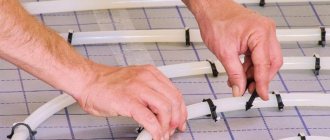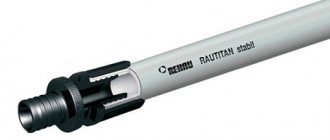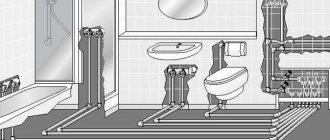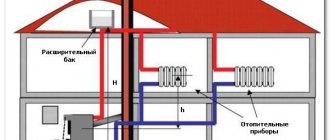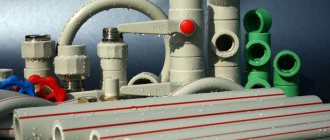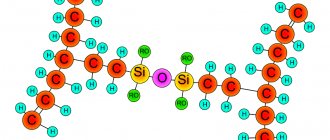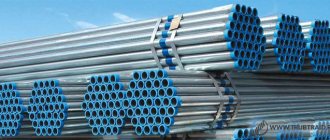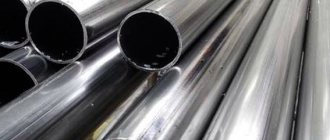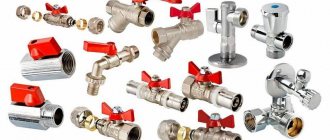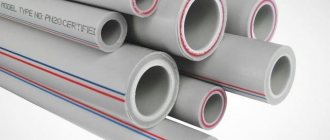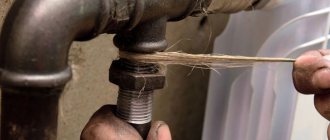Characteristics
There are many properties of cross-linked polyethylene pipes that make them so popular:
- The perfect combination of flexibility and strength.
- Resistant to cracking.
PE-X cross-linked polyethylene pipes
A cross-linked polyethylene pipe can last:
- More than fifty years at a temperature of seventy degrees and an internal pressure of nine bar.
- More than fifteen years, at the same pressure and temperature of 95 degrees.
The fact is that such a pipe tolerates low temperatures much better due to the cross-links formed.
If we compare the material with ordinary polyethylene, it is not so brittle, so it can be used in a wide temperature range: from minus 120 to plus 120 degrees. If there is no mechanical impact, then a temperature of plus 120 degrees can be applied for a short time.
Due to the decrease in the crystallinity of polyethylene during cross-linking, it becomes flexible and does not break under large amounts of bending.
The material is flammable because it is a pure hydrocarbon-based polymer. Temperatures above 400 degrees cause loss of shape and the material begins to drip. When it breaks down, water and carbon dioxide are formed.
The pipe may swell when exposed to oils, grease or wax. Strong oxidizing agents can corrode the product.
Cracks do not appear on the surface after contact with detergents and antifreezes.
What is rehau and why cross-linked polypropylene does not exist
Or here is a video we received from our client whose polypropylene heating pipes that were walled up in the walls leaked.
On the plumbing services market you can find offers for installing batteries of various types. All specialists, of course, have different opinions and each one also has his own approach to work - especially among universal finishers, the so-called “jacks of all trades”. They are in polypropylene, they love you... Well, because you can buy a soldering iron for polypropylene for 800 rubles and install the pipes first! Understand correctly - this is not about the fact that polypropylene pipes are a complete waste, but no, they are an excellent material, but you need to know where and how to use them. That is, you can’t use polyk everywhere, and certainly not inside the screed. That is, we will talk about the wrong choice of pipes for hidden connections and the consequences that will come out a few years later exactly after the warranty expires and how to choose the right pipes that will not delight us with such sad surprises. The fact is that the most common mistake when installing radiators with hidden connections is the incorrect use of polypropylene pipes. Which, according to technology, are prohibited from being hidden inside the screed. However, it is widely used by general craftsmen - that is, not by plumbing specialists.
The picture shows a polypropylene leak at the welding site.
Judging by the picture, you can understand that such a collective farm installation of a heating radiator was not carried out by a professional plumber, but by some kind of generalist finisher - a jack of all trades. As you can see the result of the work is obvious! Now you not only need to redo the radiator piping, but also destroy the walls and floor... sad...
This leads to the following consequences.
The figure below will show what a polypropylene pipe looks like in cross-section after it has been removed from the screed after a catastrophe with a leak inside the floor, which is usually discovered after the neighbors from below knock on your door. This does not happen immediately after starting the system, but after about 3–5 years of operation.
This drying out of a polypropylene pipe or its embrittlement is well explained in the video below. Where the author documents the opinion of many management companies that plastic pipes should not be installed on the heating system of an apartment building.
Let's look:
The first rule of high-quality apartment renovation is not to skimp on engineers. You cannot trust engineering work, such as plumbing or electrical work, to a plasterer, even if he showed you a soldering iron for polypropylene. The presence of a soldering iron and even the ability to weld polypropylene pipes does not mean anything.
If you are making repairs in a new building, then you need to approach the issue of choosing a plumber very carefully and under no circumstances agree to install polypropylene pipes if these pipes, whether water or heating, are hidden inside the walls as in the figure below.
The collective farm is a voluntary business!
The image above shows an option for installing a sectional radiator using the collective farm method. Firstly, because a sectional heating radiator was chosen for hidden connections rather than a monolithic one with a decent bottom connection. And the second thing that catches your eye is the laying of pipes in an overlap - one through the other (so that the pipes cut each other under the screed, soft insulation will not save..) The second is heating with pipes made of polypropylene under the screed. This is exactly the case when at first everything is fine, all the work is handed over, the customer accepts the work and sleeps peacefully for the first three years. Enjoying the new renovation of the apartment and never dreaming that the pipes under the screed are vibrating, either expanding or contracting in size depending on the temperature of the coolant. Slowly loosening the welded joints hidden deep inside the screed and hello to the neighbors below.
This occurs due to the high temperature expansion of polypropylene pipes. Google to help - “coefficient of thermal expansion of polypropylene pipes” Well, for example, they soldered all the pipes and when they turned on the heating and the pipes got hot...
Of course, if you turn off the heating, the pipes will fall back into place, and the radiator branch will again take its normal appearance. So the principle is clear? It is obvious what happens with polypropylene pipes during thermal expansion and contraction when it cools and heats up again. Such vibration is not weak and can loosen any connection, especially if it is in a screed protected by soft thermal insulation - which does not protect the pipe in any way. For example, such expansion compensators are installed on hot water supply risers.
An expansion compensator is not needed on a cold water riser. In the case of installing heating radiators with open-laying polypropylene pipes, namely open, this is the correct use of polypropylene pipes. Expansion compensators are installed by competent plumbers in the design of the radiator piping.
Well, that is, the principle is clear - the pipe has room to move during expansion, the expansion itself is not noticeable to the eye if, as mentioned above, thermal expansion compensators are taken into account in the design. And if there is nowhere, then here..
But this has already been discussed above, and in order not to be repeated, it’s time to move on to the question of the correct - hidden laying of pipes inside the floor or walls. For this purpose, Swedish engineers from the company “Uponor” or the old name “Wirsbo” developed a special material called cross-linked polyethylene or simply cross-linked or PEX.
Who sews it and with what? The fact is that the technology of cross-linking polyethylene is achieved at the molecular level using special irradiation of ordinary polyethylene, after which the polyethylene molecules begin to have a special molecular memory that they - the polyethylene molecules - acquired after this very irradiation. Now this is not just a pipe made of “Pert” type polyethylene, but a highly reliable “PEX” type pipe made of molecularly cross-linked polyethylene, which remembers its original state at the time of irradiation and always strives to return to this state, no matter what loads it is subjected to. Watch a video about how a man abuses a pipe by breaking it and heating it with a burner and it returns to its original state.
And this is the polypropylene pipe that we discussed above. (cracked from stress..)
Well, that is, the difference between pipes for hidden installation inside the walls and under the screed is obvious. The stitching is intended specifically for high-quality internal lining, and the polyester is intended only for external lining. Do not confuse this when communicating with a plumber and check with the appropriate questions the master for his competence. Here is an option for the correct replacement of a heating radiator in the Tsvety residential complex in Nizhny Novgorod on Sakharov Street.
The expansion coefficient of pipes made of sieve polyethylene is even higher than that of polypropylene, but this is not scary because it does not bunch up at the seams inside the screed as described above, but simply walks or fidgets inside a special rigid corrugation. Which is required when installing heating pipes inside the screed. Sometimes, during a major renovation of an apartment in a new building, there is a need to move the heating radiator. Often this is necessary in order to move the heating radiator to a glazed loggia or to the wall in order to free up space from the balcony partition and make the loggia or balcony an extension of the room.
To move a radiator in a new building, a special press tool from “Rehau” or “Uponor” is required. Such a tool costs about 100 thousand rubles. Therefore, the finisher cannot have it. And connecting collective farms under the screed. Working with cross-linked polyethylene requires a special installation tool, which is not cheap, so not every plumber has it in stock. In connection with this, you may receive proposals such as to fake threaded connections and switch from cross-linking to poly, reject them immediately. This issue was discussed in detail above. Such a collective farm should end up in a way that you know what will lead to.
For those plumbers who have tools for working with cross-linked polyethylene pipes, the cost of moving a heating radiator to a balcony or wall starts from 4,500 rubles. Not cheap, but of high quality in compliance with all SNIPs for the installation of hidden pipelines.
Braided pipes are laid so that the cross-linked polyethylene pipe can move freely as it expands and contracts inside the protective jacket; all turns are made for this purpose as smooth as possible without sharp corners and pipe clamps inside the protective jacket.
It is also necessary to properly insulate all joints so that the main cross-linked pipe does not come into contact with the concrete screed in any way, in order to avoid chafing and destruction of the pipe after a certain period of operation, to the point of complete destruction and leakage. Competent plumbers from the Trubservice Nizhny Novgorod company carried out work on moving heating radiators and heated towel rails with hidden connections inside the walls made of cross-linked polyethylene in all districts of Nizhny Novgorod and in almost all new residential complexes. Such as Julieverne, Flowers, Seventh Heaven, Water World, and Residential Complex South. For reference, we provide prices for all types of work on borrowing and moving heating radiators throughout Nizhny Novgorod.
Installation
Installation can be done using two methods:
Press fittings
This method makes it possible to reliably connect water pipes made of cross-linked polyethylene. Its disadvantage is its inseparability. You will also need a press tool for installation.
rehau pipe - cross-linked polyethylene, equipped with a fitting
Installation proceeds as follows:
The continuous sleeve is first placed on the pipe. Next, an expander of suitable diameter is inserted onto it until it stops.
Then its handles are brought evenly all the way, fixing for a few seconds.
Next, the fitting is inserted into the pipe, also until it stops.
Using a press, the sleeve is pressed onto the fitting.
PEX pipe crimping
Compression fittings
Such fittings make installation easier. They can be used for both hot and cold water supply without the use of special tools.
Components of a compression fitting
To connect, you will need two wrenches along with pruning shears.
The connection is made like this. The crimp nut is placed on the end of the pipe using a wrench. You should not use much effort to avoid cutting through the pipe. Next, the split ring is put on. Its edge relative to the pipe cut should be at a distance of 1 mm.
Next, the product is pushed onto the fitting fitting until it stops.
Is it worth using?
Cross-linked polyethylene pipes are an excellent material for building a reliable and durable water supply system. The main thing is to take into account all the installation nuances and apply the correct method. And then the water supply will last a long time.
Source
Installation instructions
Installation of communication pipes made of cross-linked polyethylene is often done by hand . There are several types of connection of individual elements in the system:
- compression;
- pressing;
- electric welded
Installation of cross-linked polyethylene pipes according to instructions
The assembly of a cross-linked polyethylene pipeline using any of these methods is carried out using various fittings.
Before you begin installation, you should prepare a set of necessary tools:
- a pipe cutter that will ensure an even cut of the pipe at an angle of 90 degrees;
- hydromechanical press;
- collet expander - helps to increase the lumen of the pipe and easily insert the fitting into it;
- pliers;
- fitting;
- wrenches - used when tightening a nut.
Important! If you decide to use the welded joining method, you will need a specialized apparatus, which is often rented.
Now we will consider in detail the simplest and most accessible methods of combining cross-linked polyethylene pipes.
Connection with compression fittings
The compression method has proven itself excellent both in the installation of plumbing systems and in the installation of heating systems.
Algorithm for performing the work:
- cut the element to the required length and put on a nut, the thread of which will be directed towards the connector;
- install a split ring on the edge of the element - it is mounted quite simply and is placed at a distance of 1 mm from the edge of the segment;
- insert the fitting into the pipe so that the ring is on the fitting of the connection element;
- move the nut and start screwing it onto the connector using wrenches.
Important! During the tightening process, the main thing is not to overtighten the nut and not to strip the thread from the fitting, but at the same time try to tighten the connection tightly and efficiently.
This method is applicable if a pressing machine is not available.
Press fittings
This fastening method effectively connects the pipes, but it is worth understanding that such communications cannot be dismantled.
Assembly steps:
- a press sleeve ring is put on the end of the pipe;
- using an expander, drive the fitting into the pipe - it should fit quite freely and all the way;
- A press sleeve is placed on top of the fitting, which will tightly clamp the fitting, since this material has molecular memory.
The process is a little more complicated than what was described earlier, but the fastening turns out to be more reliable in stressful situations, for example, when the pressure in the heating system increases sharply.
Electric welding connection
Before using this method of connecting polyethylene pipes, you should prepare a device used for this purpose by specialists.
The connection instructions are as follows:
- a welded coupling is installed at the end of the pipe;
- an electric welding unit is connected to the terminals on the fittings;
- both sections of the pipe are connected and electric current begins to be supplied to the inside of the fitting until the ends of the pipes heat up and stick to each other firmly enough;
- then the device can be turned off and wait for the structure to cool completely.
Connections made by welding can withstand pressures of more than 12 atmospheres.
Once the installation is completed, you can connect the system to the collector and check its performance.
Features of the material
Polyethylene is produced by polymerization of ethylene. During the crosslinking process, the chemical composition of the material does not change - this technology significantly improves the characteristics and capabilities of polyethylene, that is, the applicability of the finished product expands.
The most important advantages of such pipes include:
- resistance to high temperatures: without pressure can withstand up to 200 ºC without changing the configuration;
- high shock resistance, down to temperatures down to -50 ºC;
- presence of balance between elasticity and hardness;
- are not afraid of oxidation;
- pipes have excellent smoothness and flexibility, capable of neutralizing mechanical vibrations and sounds;
- not exposed to chemicals;
- the material does not contain heavy metals;
- the ability of the material to bend easily without being damaged;
- small dimensions, light weight, long service life.
Such polymer materials have the property of shrinkage, that is, they can return to their original shape after a certain period after stretching. In addition, special complex tools for installing cross-linked polyethylene pipes are not needed.
conclusions
Before you begin installing cross-linked polyethylene pipes yourself, it is recommended to draw a general and most detailed diagram of the pipeline network, indicating all sections of connections, installed fittings and taps. The quantity of materials and components is calculated in accordance with the drawing.
It is necessary to prepare working tools: scissors for cutting bends, adjustable wrenches and a welding tool. Guaranteed high quality of the result and reliability of the entire installed system will be ensured not only by correct installation, but also by the use of PEX pipes and axial fittings.
Checking the quality of installation
The main indicator of correctly made connections is the complete tightness of the joints. To check the installation components, a compressor pressure tester is used - a kind of pressure blower that is installed on a certain section of the pipeline. The tactics for performing pressure testing depend on the system in which the pipes were installed. It is advisable to test cross-linked polyethylene for heating or water supply on separate sections between shut-off valves. The line is cleared of air and filled with water, after which it is left under the control of the pressure tester for several hours. Pressure readings are recorded before and after completion of the procedure. If there is a difference between the readings, this may indicate a leak.
Polyethylene cross-linking technology
Cross-linking is needed to eliminate one of the main disadvantages of the material – thermoplasticity. Thanks to this process, the XLPE pipeline remains flexible without changing its shape even at temperatures above 80 ºC.
It is worth noting that due to the saturation of the material with pure carbon, its melting begins only when it reaches 400 ºC.
The technical characteristics of the product are influenced by the stitching method, which can be:
The first method involves carrying out a substitution reaction. For the second, the raw material is mixed with an inhibitor, and the crosslinking itself is carried out under pressure. The third method involves irradiation, during which the bonds change due to substitution.
Preparation for installation work
The collector outputs should be the first elements that require increased attention.
Only their correct processing will ensure complete tightness in the system. Before installation, the workplace must be completely free of dust and debris, as well as the equipment. Welding, threading and gluing are the methods that are most widespread during installation. You just need to purchase the appropriate type of fitting, depending on the installation method you choose. Watch video: Bir Pex systems
Absolutely all parts used during installation must be intact and clean. A visual inspection is required before purchase. This will ensure the quality of the finished product. Their transportation deserves special attention.
IMPORTANT! In the winter season, this requirement is especially important for materials made of cross-linked polyethylene. After all, cross-linked polyethylene products do not allow hypothermia, and when exposed to low temperatures they become deformed and lose their properties.
Preparatory work
All connection work should begin from the collector outputs. This will thoroughly ensure complete tightness of the system and easy installation of the elements, since Rehau products bend easily. When purchasing fittings, pay attention to those types that are intended specifically for the named type of pipe. At the same time, it would be useful to ensure that the future system is protected from condensation or heat loss, depending on the expected temperature of the medium.
Before carrying out installation work, it is necessary to fix the cross-linked polyethylene pipe with double staples included in the kit, since high elasticity will prevent it from maintaining the given shape.
Dependence of types of pipes on installation in different places
Tools for installing polyethylene pipes may vary slightly depending on their application. For different systems - heating, cold or hot water supply, sewerage - there are different conditions for water transfer, therefore the products will differ in each specific case.
For example, to supply cold water, as a rule, single-layer pipes made of cross-linked polyethylene with a cross-section of 16-20 mm are used, which can withstand up to 95 ºC. Often such pipes are produced using the electron beam method - these products have an affordable price.
Hot water pipelines require multilayer structures, since the temperature they must withstand is in the range of 110 ℃, that is, quite high. For this purpose, in such products, a layer of cross-linked polyethylene obtained by the peroxide method is placed on the inside, an aluminum layer is placed in the center, and another layer of polyethylene is placed on top.
Thanks to the presence of a central aluminum layer, the pipe becomes strong enough at the bend to prevent oxygen from entering it. But the outer layer of polyethylene can protect the pipe from ultraviolet radiation and mechanical damage. The cross-section of such pipes is in the range of 16-63 mm. In the case of heating systems, you can also use multilayer products with parameters of 16-20 mm.
Types of cross-linked PE pipes
Pipes are classified according to several criteria:
- By purpose. Universal products are used to organize heating systems and underfloor heating. Specialized ones are used either for arranging heating communications or installing a heated floor system. Any type of product is suitable for installing a water supply system.
- According to the firmware method. Depending on the processing method, the pipe is assigned the appropriate grade. The firmware can be peroxide (PEXa), electronic (PEXc), gas (PEXb) and chemical (PEXd).
- By manufacturer. The most popular are products produced by the German concern RAUTITAN. The buyer is offered several types of pipes with different diameters. The Finnish company WIRSBO produces products of medium and small sizes. The widest range is presented by the Israeli manufacturer GOLAN. The company offers products made of cross-linked polyethylene with a diameter of 12-500 mm.
Rules for working with cross-linked polyethylene
Installation of polyethylene pipes is carried out in compliance with the following rules:
- Elements made of polyethylene must have cuts made at an angle of 90°. They are produced perpendicular to the horizontal axis.
- The edge of the cut must be smooth; the presence of sharp protrusions and burrs is not acceptable. This is the only way to ensure a reliable connection between the elements of the heating and plumbing systems. If there are defects during fastening, the edges are deformed even more, and the tightness of the joints is broken. The problem is identified only during the operation stage.
- For cutting you need to use high-quality pipe cutters. The tool looks like scissors with sharp blades that easily cut thick walls. Pipe cutters have different prices; for self-installation of polyethylene pipes, you can use inexpensive models.
Types of fittings
It is very simple to bend pipes made of cross-linked polyethylene - to do this, you only need to warm them up with a construction hairdryer. However, when installing the system, you may need not only bends, but also joining of individual pieces of pipe - in this case, fittings are used.
The following types of fittings are distinguished according to their functional purpose:
- tees and crosses;
- corner parts;
- couplings;
- plugs;
- sweeps.
In those places where it is planned to change the direction of the pipeline, corners are usually used. In straight sections, couplings are used for joining. If it is necessary to extend an additional section to the finished pipeline, then use spurs. The purpose of tees and crosses is to route the pipeline, and the plugs are used to close the ends.
At the same time, there are several types of materials for fittings:
- polyvinyl chloride;
- polyethylene;
- polypropylene;
- combined material.
The most commonly used fittings are brass. Pipe sections of the same cross-section should be connected with straight fittings, and pipe sections of different diameters with reduction fittings.
Frequent errors and problems during installation
When installing a press fitting, it happens that the installation is repeated. This should not be allowed, since in this case it will not be possible to ensure the required level of system reliability.
Before installation, it is necessary to process the end sections of the pipes. When cutting polyethylene, burrs occur. If they are not removed, they will contribute to reducing the reliability of the seam joint. In addition, during operation, polyethylene particles may enter the lumen of the pipeline.
Technique for fastening compression fittings
To work with these types of parts, you will need two wrenches and pruning shears.
The assembly of cross-linked polyethylene pipes into a single pipeline using compression fittings is carried out in several steps. At the first stage, a crimp nut is placed at the end of the pipe. Its thread should face the connector. Next, fix the split ring, installing it so that the distance from the pipe cut to the edge of the ring is 1 mm.
At the end, a section of cross-linked polyethylene pipe, with a nut and ring attached to it, is pushed onto the fitting fitting until it stops. After this, use wrenches to tighten the crimp nut tightly. Please note that before putting the pipe on this fitting, it does not need to be disassembled or chamfered. The only precaution when working with these elements is to control the effort when tightening the nuts so that the pipe does not deform.
Connection using crimping
To make a connection on press fittings, you need the following tool:
- pipe cutting scissors;
- expansion gun having nozzles of different diameters;
- vice for crimping.
First, the end of the cross-linked polyethylene pipe is cut as accurately and evenly as possible with special scissors.
Note! The cut of the product must be strictly perpendicular to its axis, without burrs or other defects.
Next, a sleeve is put on, to which the crimping method will subsequently be applied. It is important to take into account that it is put on before expanding the inlet of the pipe itself, since then the sleeve simply will not fit.
After this, selecting a nozzle of the required diameter and using a special tool - an expansion gun, the entrance (end) of the product is increased in diameter by several millimeters. The fitting fitting is inserted into the resulting hole. To facilitate the process, lubricant, which is usually included in the assembly kit for such systems, will help.
The final step is to fix the sleeve with a tool for crimping cross-linked polyethylene pipes. You should work with the vice carefully so as not to damage the docking unit.
Features of connecting PEX elements
The PEX material is the same thermoplastic polymer, so for connecting elements from it, methods for installing other types of polyethylene elements are quite suitable. The difference is that its elasticity will make fitting connections more airtight, and welding operations will require significantly higher temperatures.
Connection methods
There are the following three options for solving the problem of how to connect cross-linked polyethylene:
- Compression (crimp) fittings, in which the set of tools and installation work will be the simplest. This method can be used to install both “cold” and “hot” systems, and has the ability to be easily dismantled at any necessary time.
- Press fittings (press fittings) are used to create a one-piece, but very reliable connection of pipe sections. In this case, the ability of cross-linked polyethylene to restore its shape after deformation is used: polymer molecules that straighten after pressing on the fitting completely fill special recesses and gaps, creating a reliable hermetic connection.
- Electric-welded fittings for cross-linked polyethylene are used very rarely, since this method requires special welding equipment and work skills. The welding method produces very strong and reliable pipe connections for use in various systems.
ATTENTION! When choosing a method for connecting pipes, it is necessary to take into account the pressure expected in the future system, since compression fittings can withstand no more than 2.5 atm, press fittings - up to 5-6 atm, and welded fittings are almost similar to a monolith.
Tools
For installation work with PEX pipes, you will need the following tools and materials:
- Spanners,
- Secateur knife,
- Manual or hydraulic press (for working with press fittings),
- Expanders of required diameters,
- The fittings themselves are complete.
Preparation
When working with cross-linked polyethylene pipes, remember that:
- It is advisable to carry out connection work only at the outlets of the collector tees. This will ensure greater reliability of the system, especially since when it is necessary to create turns, PEX pipes bend very well.
- When purchasing fittings, you should give preference to those that are designed specifically for cross-linked polyethylene,
- Water pipelines must be protected: for cold water supply from condensation, and for hot water - from unwanted heat loss,
- It is a good idea to provide thermal insulating gaskets and substrates before installing the pipelines.
Service specialists use one of the following methods:
- Crimping.
The fastest and easiest. A collet expander and a press fitting are used. The expander is inserted into the socket, after which the diameter of the pipe increases slightly. A fitting is placed in place of the expander, the ring is tightened and the structure is crimped with a press. - Compression fittings.
The optimal method for installing water pipes. The parts are made of food-grade brass, and the only tools required are two gas wrenches and a pipe cutter. In this case, the connection can be quickly dismantled. - Electrically welded fittings.
Inside the components there is a special heating element, which welds sections under the influence of current. A fairly reliable method, but it requires a welding machine, not to mention the need to buy such fittings.
Which one to choose depends on how the cross-linked polyethylene pipe is installed - open installation involves the use of compression couplings. The crimping method is suitable for hidden installation of a pipeline. The main thing is to make sure that it is completely sealed before moving on to facing work.
| Monday | Open 24 hours |
| Tuesday | Open 24 hours |
| Wednesday | Open 24 hours |
| Thursday | Open 24 hours |
| Friday | Open 24 hours Now open |
| Saturday | Open 24 hours |
| Sunday | Open 24 hours |
Joining pipes using crimp connections
Fastening tubular products to press fittings requires the following tools:
- fitting crimping press;
- pruning shears or scissors for cutting pipes;
- expansion gun with a set of nozzles.
First of all, the pipes are cut. It is very important that the cuts are smooth and even, without burrs - special scissors are useful for this.
A sleeve is placed on the prepared edge, which will subsequently be subject to crimping. Please note that you need to put on the sleeve before carrying out work to widen the edge - otherwise, it will no longer fit.
The next step will be to widen the pipe inlet by several millimeters using a special gun with a nozzle of the required size. A fitting fitting is inserted into the expanded entrance, making your work easier with the special lubricant included in the kit.
At the last stage, the sleeve is fixed on cross-linked polyethylene pipes with a special press. Here, too, you need to be careful not to deform the docking unit.
Pipe connection options
There are three main ways to connect cross-linked polyethylene pipes. Installation tools are slightly different in each case. The simplest is to use compression (crimp) fittings. Distinctive features of a system with such connections are:
- possibility of simple dismantling at the required time;
- simple tool;
- applicability for “cold” and “hot” pipelines.
The most reliable connection is a crimp fitting
Another way to join sections is using press fittings (press fittings). In this case, permanent but very reliable connections are obtained. This uses the property of cross-linked polyethylene to restore its shape after deformation. After crimping on the fitting, polymer molecules straighten out, fill special gaps, recesses and create a very reliable connection.
Note! When choosing the appropriate option, it is important to take into account the expected pressure in the future network, since the maximum limit for compression fittings is 2.5 atm, for press fittings - from 5 to 6 atm.
The third method - the use of electric welded fittings for cross-linked polyethylene - is the most rare, but allows you to obtain the most durable connections (comparable to a monolith). To implement it, you need a special tool and skills to carry out such work.
Installation of cross-linked polyethylene pipes
The connection of pipeline elements is carried out in several ways:
The choice of installation method depends on the required system characteristics. Before starting work, you need to prepare the following tools:
- pipe cutter (the tool helps to cut products of any diameter and get an even cut without burrs);
- Hydraulic Press;
- expander (used to increase the diameter of the lumen before inserting the fitting);
- pliers;
- wrenches of various sizes for tightening crimp nuts;
- welding machine (used for installation of electric welding fittings);
- fitting.
Connection with compression fittings
The procedure for installing polyethylene pipes using this method includes the following steps:
- Fitting introduction. The part is unscrewed, a nut and a split ring are alternately put on the end part of the pipe.
- Installation of the ring. The part is fixed at a distance of 1 mm from the cut.
- Insertion of the fitting. This part of the fitting is inserted into the lumen of the pipe, pressing until it stops.
- Tightening the nut. The part is screwed tightly, being careful not to damage it.
Since polyethylene has high plasticity, there is no need to additionally seal the joints. If necessary, the system can be quickly dismantled.
Press fittings
This method produces a strong, seamless connection. It will not be possible to dismantle the pipeline without damaging its elements. Installation work is carried out as follows:
- the pipe is inserted into a press sleeve that looks like a wide ring;
- an expander of the required diameter is inserted into the lumen of the pipe, by pressing the handle the size of the product is increased to the desired level (the pipeline element must be freely put on the fitting);
- the fitting is pressed into the expanded lumen until it stops;
- a press sleeve is put on top of the structure (after some time after expansion, the plastic material returns to its original shape, tightly squeezing the fitting).
Electric welding connection
The use of a welding machine helps to obtain a strong connection that can withstand pressure changes. The work is performed in the following order:
- the cut is inserted into the electric welded coupling;
- a welding machine is connected to the terminals available on the welded fittings;
- voltage is applied to the internal parts of the coupling, which allows welding cross-linked polyethylene (electric current heats the connecting parts to +170°C);
- the welding machine is turned off, after the parts have cooled, the material returns to its original shape.
Connection methods
There are several ways to connect parts of the pipeline during installation:
- compression (crimp) fittings;
- compression fittings;
- electric welded fittings.
The choice of a specific connection type depends on the planned operating characteristics.
To install communications, you may need the following tools:
- Special pipe cutter-scissors. A pipe cutter allows you to cut pipes into sections of the desired size without applying excessive effort. In this case, the cut will be smooth, without burrs, at an angle of 90 degrees. Such a cut will ensure high quality and reliability of the future joint.
- Hydraulic Press.
- Collet expander for increasing the diameter of the pipe before inserting the fitting.
- Pliers.
- Wrenches for tightening the crimp nut.
- Fitting.
When using electric welding fittings, you will need a special welding machine. It can be rented.
Connection with compression fittings
Installation of cross-linked polyethylene pipes using compression fittings is carried out on water supply lines. Here you will need a minimum of tools - just a pipe cutter and a wrench or adjustable wrench.
We recommend that you read: High-quality sealing of joints at the junction of pipes with polyurethane foam insulation
The work algorithm is as follows:
- The fitting is unscrewed and a ferrule nut and split ring are sequentially placed on the end of the pipe.
- The split ring is installed 1 mm from the edge of the cut.
- The fitting of the connecting piece is inserted into the pipe until it stops.
- Carefully screw the ferrule nut onto the fitting, trying to tighten it tightly, but not overtighten it.
Due to the plasticity of polyethylene, such a connection does not require additional sealing. It can be quickly disassembled if necessary.
Press fittings
The use of press fittings eliminates the disassembly of communications without damage. The connection is reliable, but not separable. For work you need a collet expander and a press fitting.
Connection installation procedure:
- A press ring (press sleeve) is put on the prepared section of pipe, moving it from the edge.
- An expander is inserted into the pipe and stretched to the size of the fitting.
- The expander is removed and the connecting piece is inserted in its place.
- Thanks to the molecular memory of the material, the pipe contracts and tightly grips the connecting fitting.
- Additional fixation is carried out by pulling the press ring onto the edge of the pipe and pressing it with a hand press.
In this connection there is no external pressure on the connection point. Quality and reliability are due to the special properties of cross-linked polyethylene itself.
Electric welding connection
Electric welding on polyethylene communications is carried out only using special fittings.
Work order:
- An electric welded coupling is placed on the prepared pipes.
- A welding machine is connected to the contacts on the fitting.
- Welding occurs when the material is heated to a temperature of 170 degrees.
- The heating time is set automatically, depending on the diameter of the pipeline. If the welding machine does not have such a function, then the welding time and temperature should be found in the documentation for the fitting.
- At the end of the welding process, the machine is turned off and the connection is allowed to cool.
This connection method is the most expensive, but also the most reliable. There are no restrictions on temperature and pressure for the operation of pipelines using electric welded fittings. The connection is stronger than the pipes themselves.
We recommend that you read: Sound insulation methods to reduce noise in a sewer riser
